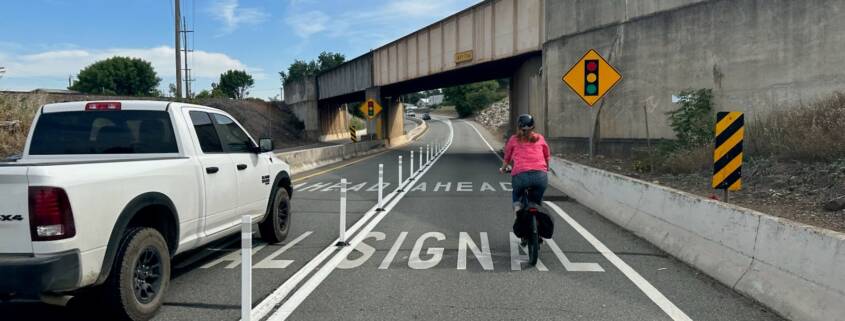Quick-Build Designs Improve Street Safety
Photo: Anne Thomas riding the “mousehole” bike lane through underpass on State Route 273.
Quick-build methods are a cost-effective way to reconfigure streets for greater safety for people walking and biking. Placing parked cars or planter boxes between moving cars and bike riders is less expensive to design and install than a raised curb. Quick-build safety measures are easier to alter as well, allowing street design to evolve on the ground, guided by user experience. For these reasons, many California communities now use quick-build methods to add active transportation improvements.
Caltrans hasn’t yet standardized quick-build for streets that are state-managed, so CalBike is sponsoring AB 891, Assemblymember Rick Zbur’s bill to create a quick-build pilot at Caltrans. Stories from our local partners of quick-build projects and needs on state routes show how Caltrans can deploy quick-build for effective, fast safety upgrades.
Quick decisions in Caltrans District 2

Anne Thomas from Shasta Living Streets shared positive experiences working with Caltrans District 2. For example, after working with her organization and the community members it organized in support, the agency was able to make a quick decision to change the capital pavement maintenance project and drop a car lane to add a Class II bike lane in a project on State Route 273. Although the first implementation of this bikeway was just paint, the decision to drop the car lane and add a bike lane helped create space for a protected two-way bikeway 10 years later in front of the new Shasta Bike Depot.
In partnership with Shasta Living Streets, Caltrans District 2 helped gain statewide approval to install the first parklet on a state highway. The parklet was built using quick-build methods. The installation was a huge success, even winning design awards.
Thomas’s group held a workshop and used data to raise awareness and generate community support for the urgent need to add a bikeway in a tunnel under railroad tracks, giving access to people walking and biking. District 2 staff approved the project and built it using quick-build methods. Thomas reports that, although this isn’t a perfect safety feature, people love it and use it. Community member Mindy Graves said, “I love the new Hwy 273 adjacent bike lane; as a resident on the west side of Redding, it’s been a great new connection to downtown.”
The experiences of Shasta Living Streets demonstrate the power of quick-build to create safe spaces for people biking and walking on Caltrans routes. Thomas credits District 2 for embracing the process. She’s seen quick-build projects that prove their worth turn into more permanent installations in time, highlighting the value of an iterative design process. The Quick-Build Bill will lend legitimacy to this well-tested method, allowing Caltrans districts to use it more widely.
The need for quick-build is real
Warren Wells from the Marin County Bicycle Coalition noted that a maintenance project on Highway 1 goes through a section of Tam Valley identified as a high priority to have a Class I separated path. But finding the resources and funding to build this using traditional materials could put off a much-needed facility, while a quick-build installation would create safer infrastructure in a spot where people are already walking and biking on the side of the highway.
Bike East Bay’s approach has been to collaborate on demonstration projects to show Caltrans staff and local governments what’s possible on state routes that run through their cities. Robert Prinz tells us that, in 2023, the group worked with Caltrans staff and the Cities of San Leandro and Berkeley on small quick-builds for E 14th Street and San Pablo Avenue, both of which are state routes.
Prinz hopes the San Leandro quick-build will show what’s possible for future segments of an upcoming corridor project called the East Bay Greenway. The Berkeley project would have used a two-way cycle track to connect two segments of a neighborhood route that jogs as it crosses San Pablo Avenue. The City of Berkeley hasn’t yet had the resources to execute the project, but Prinz hopes it will in the future.
In the absence of Caltrans leadership, communities have been left on their own if they want to add active transportation infrastructure on state routes that double as local streets. In CalBike’s review of Caltrans project documents last year, we even saw instances where Caltrans declined to devote any of its extensive repair budget to safety upgrades for people biking and walking and suggested cities needed to find the funds elsewhere.
We believe state road repair funds should serve the needs of all road users, not just people who drive. The Complete Streets Bill we passed last year puts the weight of law behind the mandate for Caltrans to allocate resources more equitably. We hope the Quick-Build Bill will give the agency flexibility to do more for pedestrian and bicyclist safety and implement fixes more quickly.
Help us pass the Quick-Build Bill. Email your assemblymember today.




